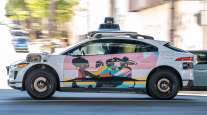Waymo Offers Peek at its Secluded Test Bed For Self-Driving Cars

A bicyclist pedaled alongside the road and a pedestrian wandered into the crosswalk, as a self-driving minivan headed through a maze of roads in a desolate landscape. As the vehicle turned right, its steering wheel rotated above the empty driver’s seat.
Autonomous car tests usually involve a safety driver poised to take control. But this was a closed course, a 91-acre former military base in Merced County, Calif., that Waymo, a subsidiary of Google parent Alphabet, has repurposed to teach its robot cars the tricks of the road. It was showing that the cars are indeed driverless, able to navigate complex situations without any hiccups.
RELATED: Regulators move to rewrite rules for self-driving cars
“We hope that riding in our cars will be like riding in an elevator,” said Julien Mercay, lead user-interface engineer.
Waymo opened its once-secret test bed for self-driving cars on the former air base to journalists on Oct. 30, as its executives touted the miles of experience their vehicles have racked up.
But the company remained coy about when its technology would be ready for the public.
“We’re getting to the point now where it’s really close, (but) I won’t give a specific date,” said Waymo CEO John Krafcik.
Waymo sees obvious commercial applications for driverless cars, he said, naming ride hailing, trucking and personal car use, as well as links to mass transit.
RELATED: Coming soon to California: cars without a human behind the wheel
“We’re also considering working directly with cities to help them resolve challenging last-mile transportation issues, (getting) people from their homes to existing public transportation,” Krafcik said.
Waymo, whose long-standing work in self-driving cars spurred major carmakers to take the technology seriously, has been testing its minivans with passengers for eight months in Phoenix. But it also operates a testing facility on the former Castle Air Force Base near Atwater, Calif. There, Waymo created a variety of topographies to train its cars, from cul-de-sacs to railroad crossings. Castle provides a menu of 20,000 structured test scenarios.
“We’re at Castle because we understand that experience is the best teacher,” Krafcik said.
Castle’s actual topography is bland: flat, dusty, brown grass with sparse trees and a handful of squat buildings.
The company showed its cars coping with challenging situations. As a minivan self-drove at 25 mph through a simulated residential street, a car abruptly pulled out of a driveway in front of it. The van smoothly braked.
In another scenario, several employees acted as if they were moving, complete with a truck with furniture and boxes, and they sent some boxes sprawling into the road in front of the minivan. Again, it braked smoothly, then waited for an opposite-direction car to pass before making its way around the obstacles.
While part of Waymo’s work involves teaching its vehicles to drive, the company is also studying how humans and autonomous cars will interact.
Juliet Rothenberg, product manager of user experience for Waymo, said the switch to autonomous vehicles requires rethinking the basic relationship between people and cars.
“You’d know how to operate a Model T,” she said. “The experience of a fully self-driving car will be fundamentally different. The challenge is to transition people from the paradigm of a driver that’s existed for over a century to being a full-time passenger.”
Approaches include a vehicle console that gives passengers a sense of control over their ride, with buttons to start the ride, request the car pull over, lock or unlock the doors and call tech support. Waymo is also working on a frustration well known to any Uber or Lyft rider: making sure the car can find the passenger, wherever he or she is.
In addition, Waymo’s vehicles show passengers visualizations of their ride to help them feel more comfortable. While robot cars “see” the world in a cloud of data points generated by their sensors, Waymo’s minivans display for passengers a rendering of solid objects identified as pedestrians, cyclists and emergency vehicles. It looks like basic computer animation, but can display details as small as orange traffic cones on the road.
Waymo has developed “a whole new visual design language for self-driving cars to communicate with users,” said Ryan Powell, Waymo’s head of user interface design. That includes onscreen messages about situations such as construction and school zones so passengers will understand why the vehicle is slowing.
Although the company has driven some 3.5 million autonomous miles in 20 cities, that distance pales in comparison with what Waymo does with virtual training.
“We have the equivalent of a fleet of 25,000 cars driving around every minute of every hour of every day,” said Dmitri Dolgov, vice president of engineering. “Everything we learn in the virtual world we can take and apply to the real world.”
Dolgov emphasized Waymo’s focus on cars that are capable, reliable and safe.
“They have to be able to handle any situation they might encounter on the road, no matter how challenging,” he said. “They have to work not once, not twice, but all the time.”
Toward that end, all the cars’ systems have built-in redundancy, he said, showing a video of engineers cutting the connecting cord to the car’s main computer with scissors, so the backup computer would take over.
The cars have “a deep semantic understanding of the world around us,” Dolgov said.
They can detect and classify all kinds of objects around them, interpret their motion, understand their intent and predict what they’ll do next.
“To understand the road, anticipate and react early — those are key,” he said.
Distributed by Tribune Content Agency, LLC




